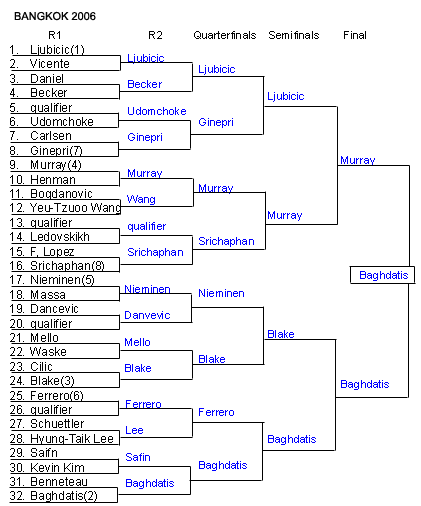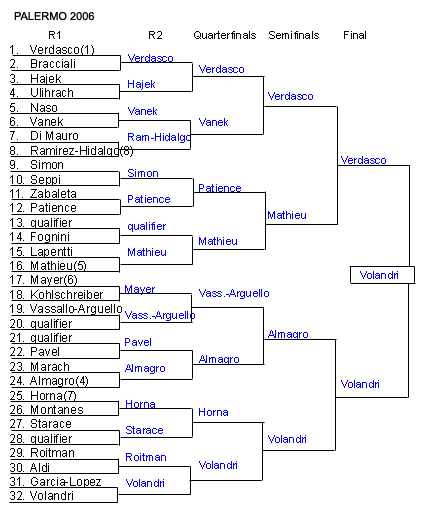The first tennis match I ever saw was a Davis Cup match in Los Angeles in the early 60s. Or maybe it was the late 50s. Time certainly flies by in the tennis scheme of things. We were playing the Aussies, as usual, with McKinley and Ralston and that red-headed guy with the massive wrist, Rod Laver. I remember the charged up atmosphere and thinking, “Gee, this tennis watching could be fun.” Much has happened since Davis Cup back then. The excitement level dropped off considerably over the years as the rest of the tennis world caught up to us. Now it’s the Americans who aren’t into Davis Cup like they used to be.
Perhaps this may account for Davis Cup Captain Patrick McEnroe’s rather dour-sounding comment after the USA lost the deciding fourth match on Sunday: “It was a classic Davis Cup match, and I’m only sorry so many people back home won’t appreciate just what it takes for both guys to play at that level for nearly five hours.” This may have been aimed at the OLN Network which covered the match but with a time delay. Anyone on the internet would have known the outcome ahead of time.
But if you could manage your way around the TV schedule, then you got a great match. It was certainly the longest fifth set in World Group play since ’85, running to 17-15 for a combined total of 4 hours and 48 minutes. Unfortunately, it was a match you hate to see anyone lose, especially an American.
Andy Roddick hauled himself out of the doldrums of being two sets down and nearly came back to pull it out in five sets. But not quite. Although Roddick played well as the match went on, he could not cash in on the big moments in the match, which kept slipping away from him. Like his golden opportunity in the fifth set after Roddick had just broken Tursunov and got ready to serve the match out. Only he didn’t. Tursunov crushed another great cross court forehand winner for the early lead, then pounded a good return off of a big Roddick serve for 15-30. Then Roddick netted an easy forehand for 15-40. He saved one break point then pulled a forehand wide and Tursunov was given new life.
You felt for Tursunov, though, who played his way to a two-set lead only to see it start to go. He’s a guy who supposedly can’t play on clay, a guy who got dropped into the action when the coach decided at the last moment to play a big server as opposed to the modest-serving Mikhail Youzhny. Tursunov has been my pick for Most Improved Guy this year. We have been singing his potential since the final at Los Angeles in the summer where he lost a close match to Tommy Haas.
The only stick on the Russian was that he sometimes implodes at key moments, or gets impatient. Today he kept his brain under control. The Russian took it to Roddick both on his serve and with an incredible display of forehand power. Big crushing cross court shots for outright winners, little angled cross court shots, inside out forehands. Also the ample use of drop shots, half of which connected. We like to think Andy Roddick is the Power Meister but today Tursunov just outhit the American. He went for his shots and he went for them big.
Then there was a little brouhaha after the match ended with Tursunov shoving away some team member as he tried to shake Roddick’s hand at the net. Igor Andreev landed a kiss on Tursunov’s cheek that ended up going to the lips instead and that had us all worked up there. For a minute you would swear this was the hottest kiss since Tosca planted one on Scarpia. “Great Kisser” reads the logo on Tursunov’s T-shirt on the ATP website. Now we know he means business.
Meanwhile in the stands we have the ever amiable Boris Yeltsin, watching with the serene appreciation and contentment that can only come when you are no longer President. Did he get kissed too? We are uncertain. The beautiful Russian women were out in force too, as my partner likes to observe. Hopefully some of them are free and swimming in the pool of available sex partners and they don’t all belong to Safin.
Another interested spectator watched from the stands. He looks vaguely familiar too…but would anyone there have recognized Yevgeny Kafelnikov? He’s hiding under about twenty extra pounds I would guess; the hair is much darker, and he’s wearing a suit. Sigh. So much for the tall, willowy blond I used to like looking at. Another good man gone the way of all flesh we suppose. It’s a wonder they could tear him away from the poker tables, where the man reportedly spends a lot of time these days.
For Roddick, this loss, 6-3, 6-4, 5-7, 3-6, 17-15, has to be a tough one. Even though he came back, you could feel the battle for him was always uphill. Perhaps it was just the clay surface that also caught the Americans at a disadvantage, but it seemed Roddick could not find that extra gear he had discovered under Connors’ guidance at the Open. His slice serve worked well when he got it out wide in the deuce court, but he barely used it. Ditto the backhand up the line shot.
For Tursunov, though, there was only one gear on Sunday, but that was enough. Big and bigger. He went for everything, especially on the forehand. Again and again Roddick tempted fate by going into the forehand; Tursunov responded by slapping yet another vicious cross court winner past him.
Said Roddick later, “To be honest, he played a lot more consistently than I thought he might. I don’t know if I could tell you what made the difference.”
At least Roddick was able to come back from two sets down; that is the great news. The not so great news is that the “old Andy” problems started creeping back in. Like the fact that mentally he still lets down at the crucial moments. When the other guy is stepping it up, Roddick seems to back away from the moment. He let Tursunov get in control of the points, and if Roddick expected a wiltdown of sorts, he was not going to get it on this day.
Another note on the coverage re OLN: for some reason the director would start with the usual shot of the tennis court, seen from behind and above, but then he would cut in for a close-up of a player as he hit a shot. The effect was jarring, you kept wanting to go back to the larger shot because the close-up was too swift to reveal much of anything. Maybe this is one director who really NEEDS to be shooting music videos, instead of tennis matches.
You can read about the final between Tursunov and Tommy Haas in Los Angeles here.



